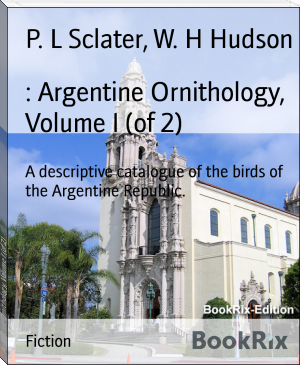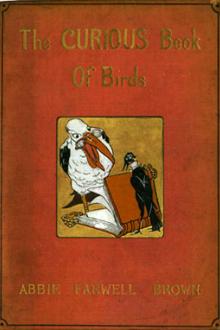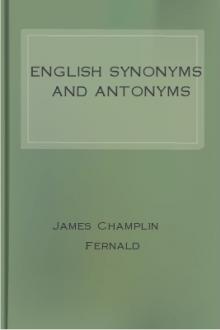: Argentine Ornithology, Volume I (of 2), P. L Sclater, W. H Hudson [best authors to read txt] 📗

- Author: P. L Sclater, W. H Hudson
Book online «: Argentine Ornithology, Volume I (of 2), P. L Sclater, W. H Hudson [best authors to read txt] 📗». Author P. L Sclater, W. H Hudson
of Southern Brazil, which only just comes within our limits.
The Snipes and Plovers and their allies, constituting the Order
Limicolæ, are again in excess in the Argentine Avifauna, not less than
25 out of a known total of 73 Neotropical species having been already
met with within our limits. A large proportion, however, of these birds
are merely winter visitors, and breed only in the far north. On the
other hand, the Slender-billed Plover (_Oreophilus ruficollis_) and the
Winter Plover (_Eudromias modesta_) are species highly characteristic of
the Patagonian subregion, and come to the neighbourhood of Buenos Ayres
from a contrary direction. Another especially characteristic Patagonian
family of this order is the Thinocoridæ or Seed-Snipes, of which two
species occur within our limits.
Of the Gaviæ, or Gulls and Terns, of the Argentine Republic, nine
species are already known out of a total of 53 Neotropical members of
the group, and additions no doubt will be made to the list when the
coast-birds of La Plata come to be better known.
The seventeenth order of Birds, Pygopodes, is represented in the
Argentine Ornis by five species of Grebes. Two of these are widely
diffused over all America, the remaining three are Antarctic species
belonging to the Patagonian subregion. As only nine species of this
groups are known to occur in the whole Neotropical Region, the Pygopodes
are highly in excess in the Argentine Avifauna.
The Impennes, or Penguins, which form the eighteenth order of birds,
according to the arrangement of the 'Nomenclator,' are a group specially
characteristic of high Antarctic latitudes. Nine species of Penguins
occur on the coasts of Antarctic America, but one of these only is as
yet known to reach so far north as our limits.
We now come to the Crypturi or Tinamous, an order of birds commonly
supposed to be Gallinaceous, and generally confounded with "Partridges"
and "Pheasants" in the vernacular. They are, however, in some points of
essential structure more nearly allied to the Struthiones, although they
doubtless fill the same place in the economy of Neotropical Nature as
the true Gallinaceous birds in other lands. The Tinamous are spread all
over the Neotropical Region and number about 36 species. Eight of these
occur within the Argentine Republic; and amongst them we may pick out
the Martineta Tinamou (_Calodromas elegans_) and the three species of
the genus _Nothura_ as being specially characteristic Patagonian types.
Lastly, we come to the final order of the Neotropical Ornis in the shape
of the Rheas, or the American representatives of the Ostrich-type of
bird-life. The Rhea is, above all other birds, a most characteristic
representative of the Avifauna of the Patagonian subregion. It is true
that it ranges far north throughout the campos of Inner Brazil, where
the outlying members have become developed into an almost distinct
species or subspecies, _Rhea americana macrorhyncha_. But south of
the Rio Negro of Patagonia another very distinct type of Rhea, almost
subgenerically different, is met with and extends thence to the Straits
of Magellan. _Rhea_ has also been lately ascertained to occur on the
western side of the Andes in the Chilian province of Tarapaco; so
that this fine form of bird-life is diffused nearly over the entire
Patagonian subregion, and is well entitled to be termed one of the most
characteristic features of the Patagonian Avifauna.
In conclusion, therefore, we may sum up our present knowledge of the
Argentine Avifauna somewhat as follows:--
The Argentine Avifauna comprises 434 species of birds, referable to 54
families and genera.
All the twenty Orders of the Neotropical Avifauna have representatives
within its boundaries, except the _Opisthocomi_ or Hoatzins, which are
restricted to the Amazonian subregion.
The most numerous families of the Argentine Avifauna are, among the
Passeres, the Finches with 46 species, the Tyrants with 63 species, and
the Wood-hewers with 46 species. Among the remaining Orders, the Diurnal
Birds of Prey with 19 species, the Waterfowl with 22 species, the Rails
with 13 species, the Snipes with 15 species, and the Tinamous with 8
species, are likewise well represented.
Genera characteristic and proportionately numerous in species in the
Argentine Avifauna are _Poospiza_ and _Phrygilus_ among the Finches,
_Tænioptera_ and _Cnipolegus_ among the Tyrants, _Synallaxis_ among the
Wood-hewers, _Fulica_ among the Rails, and _Nothura_ among the Tinamous.
Less numerous in species, but highly characteristic forms of the
Argentine Ornis, are _Thinocorus_, _Rhynchotis_, and _Rhea_.
The following ten genera, mostly monotypic, are, so far as we know at
present, restricted to the limits of the Argentine Avifauna or its
immediate confines:--_Donacospiza_ and _Saltatricula_ (Fringillidæ);
_Coryphistera_, _Anumbius_, _Limnornis_, and _Drymornis_
(Dendrocolaptidæ); _Rhinocrypta_, with two species (Pteroptochidæ);
_Spiziapteryx_ (Falconidæ); _Chunga_ (Cariamidæ); and _Calodromas_
(Tinamidæ).
(Suborder I. _OSCINES._) (Order I. PASSERES.) Fam. I. (TURDIDÆ, or THRUSHES.)
Eight species of the almost cosmopolitan Thrush-family are known to
occur in the Argentine Republic. Of these, five belong to the
widely-spread genus _Turdus_, and are closely similar in structure to
our European Thrushes. The remaining three are Mock-birds (_Miminæ_)--a
group restricted to the New World, and sometimes considered more nearly
allied to the Wrens. They are remarkable as splendid songsters.
Burmeister includes in his list a fourth species of _Mimus_ (_M.
thenca_), as found in the Mendoza district; but there may be some
error in this, as _M. thenca_ is only known to us from Chili west
of the Andes.
1. TURDUS LEUCOMELAS, (Vieill. (DUSKY THRUSH.))+Turdus leucomelas+, _Scl. et Salv. Nomencl._ p. 1; _Hudson, P. Z.
S._ 1870, p. 798 (Buenos Ayres); _Durnford, Ibis_, 1877, p. 166
(Buenos Ayres); _White, P. Z. S._ 1882, p. 592 (Misiones and
Corrientes); _Barrows, Bull. Nutt. Orn. Cl._ viii. p. 85
(Concepcion); _Seebohm, Cat. Birds_, v. p. 213. +Turdus
crotopezus+, _Burm. La-Plata Reise_, ii. p. 474 (Mendoza).
_Description._--Above olive-grey, tinged with brown on the head and
neck; beneath pale grey, throat white, more or less striped with
brown; middle of belly and crissum white; under wing-coverts and
inner margins of wing-feathers fulvous; bill yellow; feet hazel:
total length 9·0 inches, wing 4·5, tail 3·7. _Female_ similar.
_Hab._ Eastern South America, from Cayenne to Buenos Ayres.
The Dusky Thrush is widely distributed in South America, and ranges as
far south as Buenos Ayres, where it is quite common in the woods along
the Plata river. It is a shy forest-bird; a fruit- and insect-eater;
abrupt in its motions; runs rapidly on the ground with beak elevated,
and at intervals pauses and shakes its tail; pugnacious in temper;
strong on the wing, its flight not being over the trees, but masked
by their shadows. It can always be easily distinguished, even at a
distance, from other species by its peculiar short, metallic chirp--a
melodious sound indicating alarm or curiosity, and uttered before
flight--in contrast to the harsh screams and chuckling notes of other
Thrushes in this district.
Whether it is a fine singer or not within the tropics I am unable to
say, its vocal powers having received no attention from the naturalists
who have observed it. With us in the temperate climate of Buenos Ayres,
where it commences to sing in September, it has the finest song of
any bird I know, excepting only _Mimus triurus_. Like the English
Song-Thrush, but unlike its near neighbours the Red-bellied Thrush and
the Magellanic Thrush, it perches on the summit of a tree to sing. Its
song is, however, utterly unlike that of the English bird, which is
so fragmentary, and, as Mr. Barrows describes it, made up of "vocal
attitudes and poses." The two birds differ also in voice as much as in
manner. The strains of the Dusky Thrush are poured forth in a continuous
stream, with all the hurry and freedom of the Sky-Lark's song; but
though so rapidly uttered, every note is distinct and clear, and the
voice singularly sweet and far-reaching. At intervals in the song there
recurs a two-syllabled note twice repeated, unlike in sound any other
bird-music I have heard, for it is purely metallic, and its joyous
bell-like "_te-ling te-ling_" always comes like a delightful surprise
to the listener, being in strange contrast with the prevailing tone.
The song is altogether a very fine one, its peculiar charm being that it
seems to combine two opposite qualities of bird-music, plaintiveness and
joyousness, in some indefinable manner.
I have never heard this species sing in a cage or anywhere near a human
habitation; and it is probably owing to its recluse habits that its
excellent song has not been hitherto noticed. Azara perhaps mistook the
song of this species for that of _Turdus rufiventris_, a very inferior
vocalist.
The nest is made in the centre of a thick bush or tree six or eight
feet above the ground, and is a deep elaborate structure, plastered
inside with mud, and lined with soft dry grass. The eggs are four in
number, oblong; the ground-colour light blue, abundantly marked with
reddish-brown spots.
This Thrush has, I believe, a partial migration in Buenos Ayres. In the
autumn and winter I have frequently observed it in localities where it
is never seen in summer.
2. TURDUS RUFIVENTRIS, Vieill. ((RED-BELLIED THRUSH.))
+Turdus rufiventris+, _Scl. et Salv. Nomencl._ p. 2; _Burm. La-Plata
Reise_, ii. p. 474; _Hudson, P. Z. S._ 1870, p. 89 (Buenos
Ayres); _Durnford, Ibis_, 1877, p. 167, 1880, p. 417 (Buenos
Ayres); _White, P. Z. S._ 1882, p. 592 (Salta); _Barrows, Bull.
Nutt. Orn. Cl._ viii. p. 85 (Concepcion). +Turdus rufiventer+,
_Seebohm, Cat. B._ v. p. 222.
_Description._--Entire upper parts olive-grey; throat white, striped
with dark brown, the striped portion extending to the chest; rest of
under surface, also under wing-coverts, rufous-red, deepest on the
belly; bill brownish yellow; feet brown: total length 9·0 inches,
wing 4·6, tail 3·6. _Female_ similar.
_Hab._ S.E. Brazil, Paraguay, Uruguay, and La Plata.
The Red-bellied Thrush, distinguished from the species just described
by its larger size and the bright rufous colour of its under plumage,
is common everywhere in the Plata region, and does not appear to be
migratory. It is a noisy, strong-winged, quarrelsome bird, closely
resembling the Dusky Thrush in its manners. It inhabits forests, runs
on the ground in search of food, and when approached darts away with
loud chuckling notes, flying close to the ground. These birds are also
often seen pursuing each other through the trees with loud harsh
screams.
The song has a faint resemblance to that of the English Song-Thrush,
being composed of a variety of notes uttered in the same disconnected
manner, with frequent pauses; but it is, both in sweetness and strength,
inferior to that of the English bird. As a rule this Thrush sings
concealed in a thick bush or tree.
The nest





Comments (0)